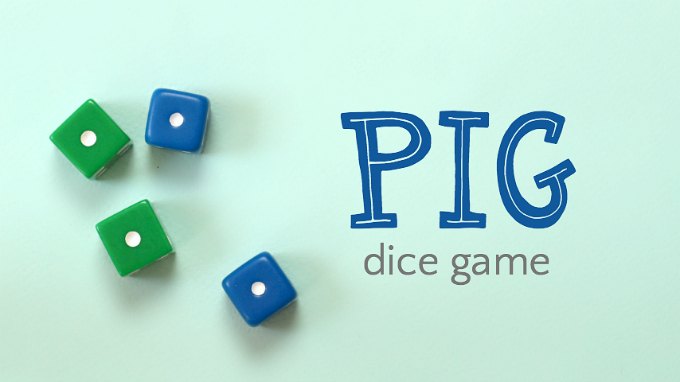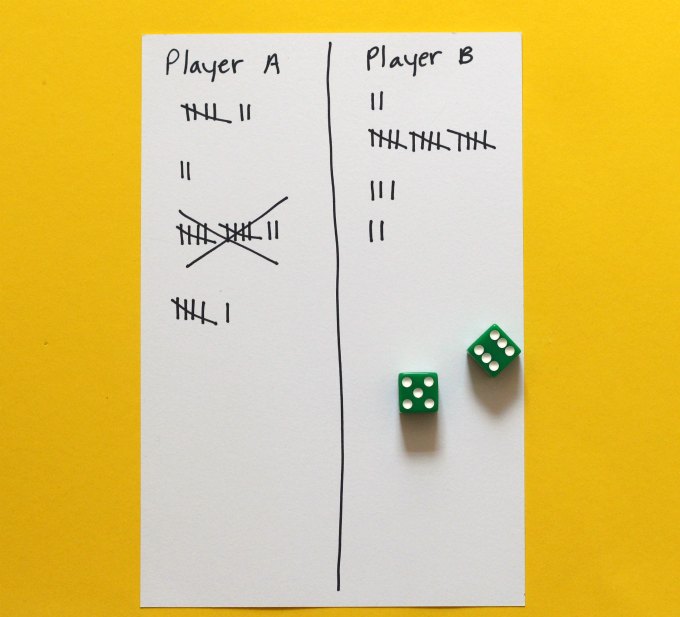How have I gotten so far in my life without learning how to play the Pig dice game? Since discovering this simple dice game for two or more players the kids and I have added it to our dinner time game repertoire. (Yes, we like to play dice and card games during dinner - don't judge.) If you have never played Pig before you are in for a treat—but don't be too greedy! Share the fun!

Pig is what's known as a jeopardy game. You will have to make risky choice to balance getting ahead without losing it all. It is a stupendous boredom buster, and is easily portable for those tricky situations when you are out of the house and need a quick boredom buster. I also love that the Pig dice game has a few variations, making it even more fun. (Note: this post contains affiliate links.)
How to Play Pig Dice Game:
What you need:
- 1 six sided die. Although you only need one, we find it easier to play if each player has his or her own colored die. We adore having colored dice like these ones, it adds to the fun, but is not strictly necessary.
- Paper and pen for scoring. (Optional if you have good memory skills!)
- 2 or more enthusiastic players
Objective:
To be the first player to reach 100 points.
Game play instructions:
Decide who will go first.
The first player rolls the die. If he rolls as 2, 3, 4, 5, or 6, he writes down the score.
If he did not roll a 1, the player can decide to roll again. If he again rolls a 2, 3, 4, 5, or 6, he adds that number to his previous score. If he rolls a 1, he earns no score and immediately passes the die to the next player.
When a player doesn't roll a 1, he can decide to continue rolling and adding the points from each roll to his total score for that turn. Or he can hold onto his points and pass the die to the next player.
However!
If the player rolls a 1, he loses all his points (for that turn only) and must pass the die to the next player.
Play continues in this manner until one player reaches a score of 100.

Strategic players will know when to hold their score and pass the die so they don't lose their points!
Tip: Keep score with tally marks. That way it is easy to track the scores per turn and you don't accidentally wipe out your total score for the game instead of just for that turn!
Why Kids Should Play Pig Dice
As you can see, Pig teaches kids to think strategically. They can't be too greedy and take too many risks or they might lose their points!
Pig also teaches the value of turn taking. Players hold on to their hard earn points when they allow others to play too!
Pig is a fun math game! Players must practice basic math skills. It also teaches kids about probability. What is the probability that you will roll a 1 on any given turn? Even without formal teaching about probability, kids will figure out instinctively that their chances of rolling a 1 increase with every roll.
Common Pig Dice Variants
Two Dice Pig:
When a player rolls two dice and one of the die is a 1, he loses the points just for that turn. If he rolls double 1s, he loses his total score!
Big Pig:
When a player rolls two dice and one of the die is a 1, he loses the points just for that turn. If he rolls double 1s, he adds 25 to his score, but must roll again!
Big Pig variation:
When a player rolls two dice and one of the die is a 1, he loses the points just for that turn. If he rolls double 1s, he adds 25 to his score. If he rolls any other doubles, he adds a double score to his total. For example, double 3s, would score 12 (because you are doubling 3+3). After rolling a double, player must roll again.
Sixes Pig:
Can be played with 1 or 2 dice, as above, but with six as the bad number, instead of 1. Of course, kids can chose to substitute any number for 1, as they wish.
Hog:
Played as above, but with any number of dice!
Your Choice:
Kids can invent their own variations, or set a different winning score.
Be sure to watch the video!
Origin of Pig Dice Game
Games of jeopardy and chance are prevalent in many cultures and traditions. Pig is a traditional game of unknown origin. In 1945, magician John Scarne published Scarne on Dice, in which he wrote down Pig's instructions.
Click here to see all of our favorite easy dice games!
- Drop Dead (not as bad as it sounds)
- Martinetti - a counting race game
- Lu-Lu - a dice game from Hawai'i



Betsy says
We'll have to check Pig out! We love Farkle, which sounds similar. I have a tiny travel-size Farkle game (about the size of an old film canister) that I sometimes just throw in my purse. We played Farkle for HOURS on a recent trip when there was lots of random wait times.
Erica says
I've actually never played Farkle. I need to!
diana says
i like the games
Linda says
I am a TA in a Primary school and during wer playtimes have taught some of the children to play Pig. They love it.
Kristen says
A friend introduced us to Farkle years before we ever saw it in the store, so we made our own with dice, paper, and a rule sheet in an empty playdoh container. Easier to pack than the bulky ones in the stores nowadays
Racquel says
Introduced this game to the kids today...they mainly liked it and guess what - We played during lunch - which we normally never do.... 🙂 Thanks
Denise says
Love the idea! Do want to point out though that the probability of rolling a 1 does not in fact increase every turn... the probability remains at 1:6 for every distinct roll.
Erica says
Yes, you are right of course! More proof that I have a degree in theater, and not math! 🙂
nancy says
however, the cumulative probability of rolling a specific number increases with each consecutive roll. So the longer you roll, the higher the probability that you WILL get that number - at some point. Each individual roll has a 1/6 probability, roll after roll multiplies the probability of getting it on your turn.
Erica says
🙂
Rhonda G says
My family loves Toss Up. It’s a game with 10 dice each with 3 green sides, 2 yellow sides, and 1 red side. As long as you roll at least one green, you can keep rolling, removing the green dice for one point each. If you roll only yellow dice, you can continue, without points. If you roll only red or red and yellow, your turn ends and you lose all points from that turn. You can end your turn at any time and bank your points. The first to one hundred wins. This game I is all about statistics, but the kids don’t know that!
We have played this at restaurants, airports, and even waiting in line at Disney. Because any number can play, we have invited many onlookers to join us. It’s a great game.
Emily says
I've played a variation of this where the "dice" are little pigs & points are based on how they land (on their feet, back, side, etc).
Cheryle Katribe says
Called Pass the Pig. I purchased a bag of plain "piggies" and marked them like the original game. Then I used small plastic cat treat holders for dice/pig cups. My elementary school kids loved playing during recess when we couldn't go outside.Can't find the plastic cat treat holders anymore, but you could use lots of things to store the pigs and use like a dice cup.
johnhenry says
I learned to play 2-dice Pig while I was in the Navy on the CARL VINSON homeported in Alameda, CA. At the time, 2-dice Pig was a bit popular at some of the small bars in San Francisco. My shipmates and I came up with some extra rules to the basic game:
1. You had to hit 100 exactly. If your roll took you over 100, then you lost all points for the turn.
2. If your roll made either your current turn's score or total score a "double number" (11, 22, 33, etc.), then you had to roll again.
3. If you rolled doubles (other than double one, of course), you had to roll again.
4. If your roll takes you to 97, then you lose all points for the turn. This one follows from rule 1, actually. If you have 97, then you need a 1-2 roll to hit 100, but that's impossible in Pig as a single 1 loses all points for the turn.
5. If your roll takes you to 98, then you lose all of your points, taking you back to zero for the game. This is because if you have 98, you have to roll double 1s to reach 100. Again, not possible in Pig.
It does sound complicated on first reading, but, to my surprise, none of us had any problems following this and it's rather enjoyable. Takes a bit more math than one would expect from people knocking a few back at a bar, though, doesn't it? 😀
Erica says
Thanks, we will try it!
Arlene says
Love it! Husband busy at work late these days due to the fact that we are still working from home. Our son has moderate cognitive delays and absolutely loves it! He thought it was a hoot when someone other than him rolled a 1. But to see him smile giggle and make piggy noises when I took more than my share of turns. This will be a game we play for a long time to come. Thank you!
Erica says
That's wonderful! Thanks so much for taking the time to let me know!
R Card-Hyatt says
We are loving Pig! We taught the grandparents and were able to play from ages 4-78--with everyone on equal terms. The 6 year old made an extra challenge by adding up the points for each round in her head. I love a game that works on dealing with disappointment throughout as opposed to merely by winning or losing at the end. And ... my four year old twins are already learning how far they can push their luck 🙂 Thanks for such a simple and fun suggestion.
Erica says
Yay! So glad they are enjoying it!